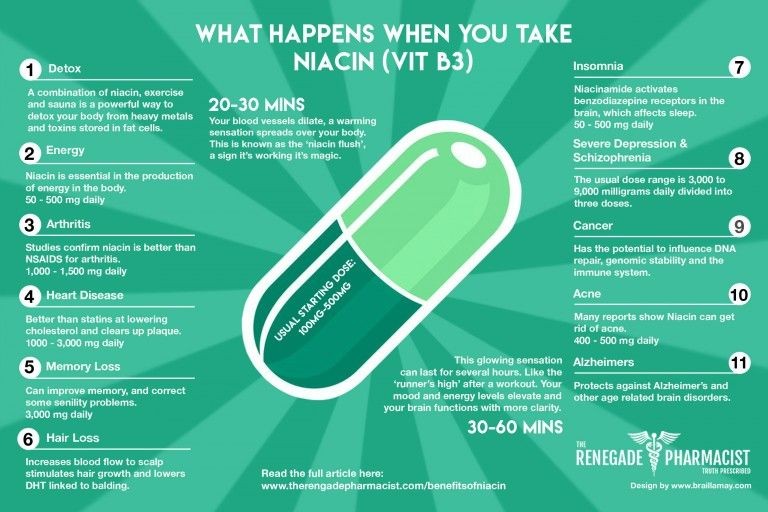
What Does Niacin Do for The Body? 7 Benefits and 5 Side Effects
Niacin is a member of the B-complex group of vitamins. It provides benefits such as energy production and improved brain health, but it also has side effects like flushing and stomach problems.
Niacin, part of the B-complex of vitamins, is water-soluble and cannot be stored in the body. It is available in two forms: nicotinic acid and nicotinamide, both of which are biologically active. Niacin deficiency can lead to pellagra, a disease that affects the skin, brain, and intestines.
Niacin plays multiple roles in the body and should be consumed regularly, but excessive intake can be harmful. Like other B vitamins, niacin helps convert food into energy by forming niacinamide adenine dinucleotide (NAD), which is important for energy metabolism at the cellular level. However, consuming large amounts of niacin won’t give you an instant energy boost.
2. Niacin improves cardiovascular health
Niacin, when taken as nicotinic acid in doses of 1 to 3 grams per day, can lower LDL cholesterol and raise HDL cholesterol levels. Lowering LDL and increasing HDL cholesterol levels is beneficial for heart and vascular health. Niacin can reduce the risk of atherosclerosis, but its high dosage can cause unpleasant side effects.
Besides its potential in reducing blood lipid levels, niacin is usually combined with other medications like statins to prevent heart disease.
3. Niacin slows aging
Niacin is involved in forming NAD, a crucial molecule for cellular functions. Aging is associated with reduced NAD levels, and NAD precursors like niacin might help slow down cellular aging.
4. Niacin and brain health
Niacin protects brain cells from stress and injury. Its deficiency can lead to memory loss and dementia. Niacin promotes the growth, development, and survival of brain cells.
5. Niacin and Alzheimer’s disease
Niacin plays an important role in brain health and the prevention of Alzheimer’s disease. It enhances learning, memory, and neurotransmission by prolonging the lifespan of nerve and brain cells.
6. Niacin and Parkinson’s disease
Niacin shows promise as a treatment for Parkinson’s disease by restoring the balance of coenzymes needed for mitochondrial activity and increasing dopamine production.
QUESTION
7. Niacin and cancer
Niacin is essential for DNA repair, and its deficiency can impair the body’s ability to repair DNA damage caused by ultraviolet light. Niacin supplementation can reduce the occurrence of cancer. Nicotinamide, a form of niacin, can also sensitize tumors to radiation and chemotherapy.
Niacin requirements
The daily niacin requirements are as follows:
| Adult men | 16 milligrams |
| Adult women | 14 milligrams |
| Pregnancy | 18 milligrams |
| Breastfeeding women | 17 milligrams |
Niacin is present in poultry, beef, and fish, mainly as NAD and NADP. Nuts, legumes, and grains provide niacin mainly as nicotinic acid. Many breads, cereals, and infant formulas are fortified with niacin to prevent deficiency disease. Tryptophan, an amino acid, can also be converted to niacin by the body.
Niacin deficiency
Niacin deficiency leads to pellagra, a disease characterized by diarrhea, dermatitis, and dementia. It is uncommon now due to fortified foods, but poverty, limited diets, and alcoholism can still result in niacin deficiency. Symptoms include skin discoloration, memory loss, hallucinations, and more.
5 niacin side effects
Niacin is generally safe at doses up to 35 milligrams per day, with rare side effects. However, excessive intake or high doses can lead to side effects including skin flushing, glucose control disorders, stomach and intestinal problems, hypotension, and liver damage. It is important to be cautious when consuming niacin supplements and consult with a healthcare professional.
References:
Advances in Nutrition: "Niacin."
Cochrane Database of Systematic Reviews: "Niacin for primary and secondary prevention of cardiovascular events."
Harvard School of Public Health: "Niacin – Vitamin B3."
International Journal of Molecular Science: "Niacin in the Central Nervous System: An Update of Biological Aspects and Clinical Applications."
Katzung G, Trevor A. Basic and Clinical Pharmacology, McGraw-Hill Education, 2015.
National Institutes of Health: "Niacin."


